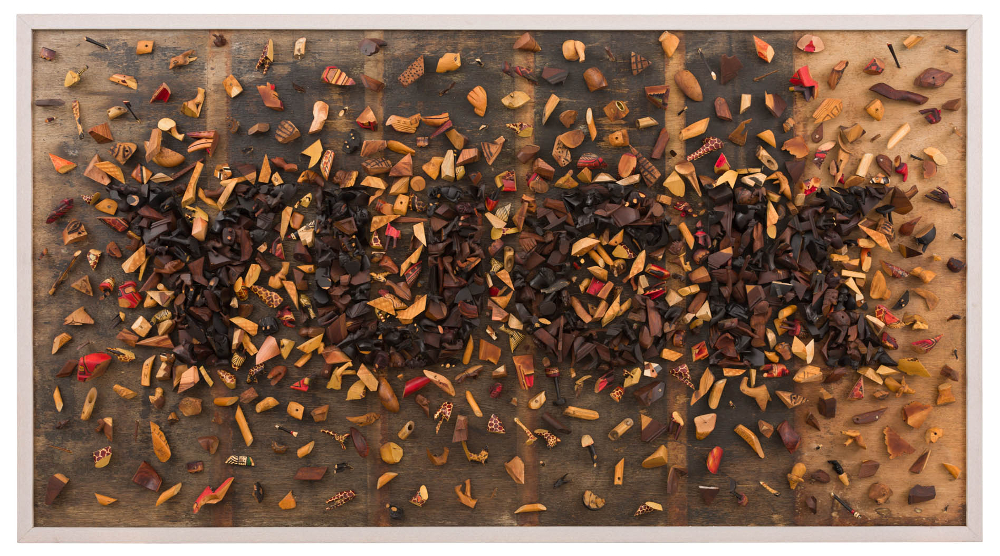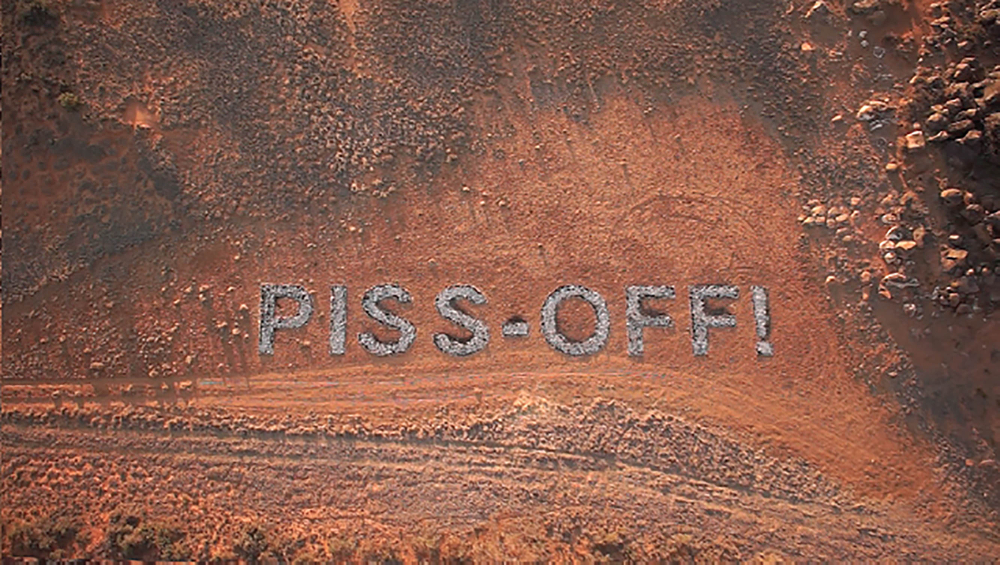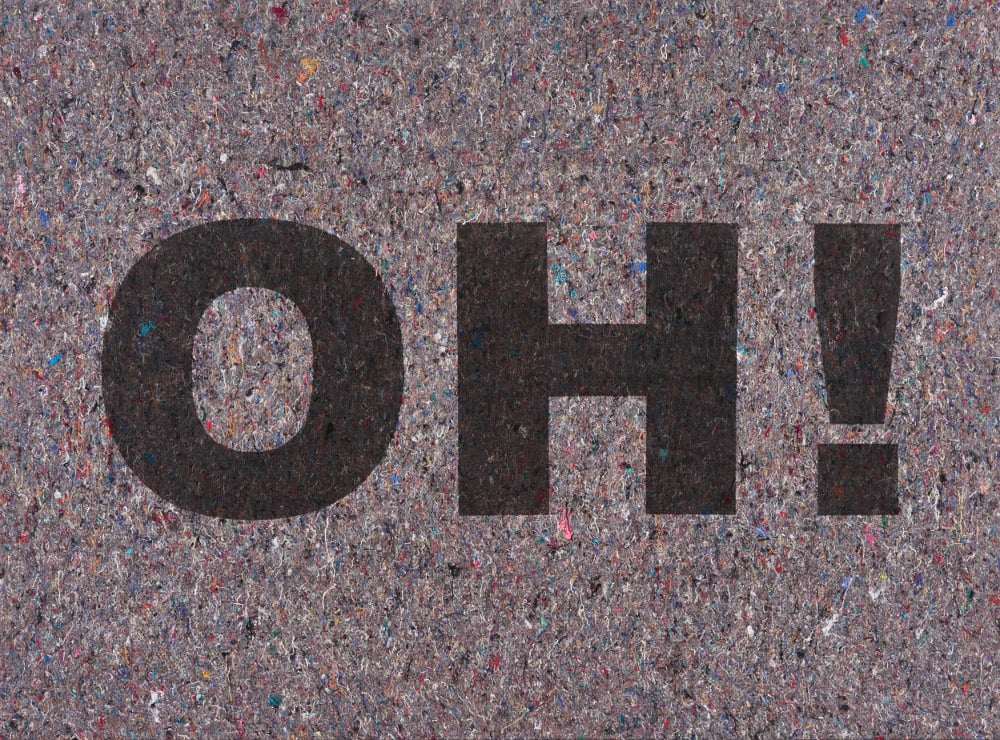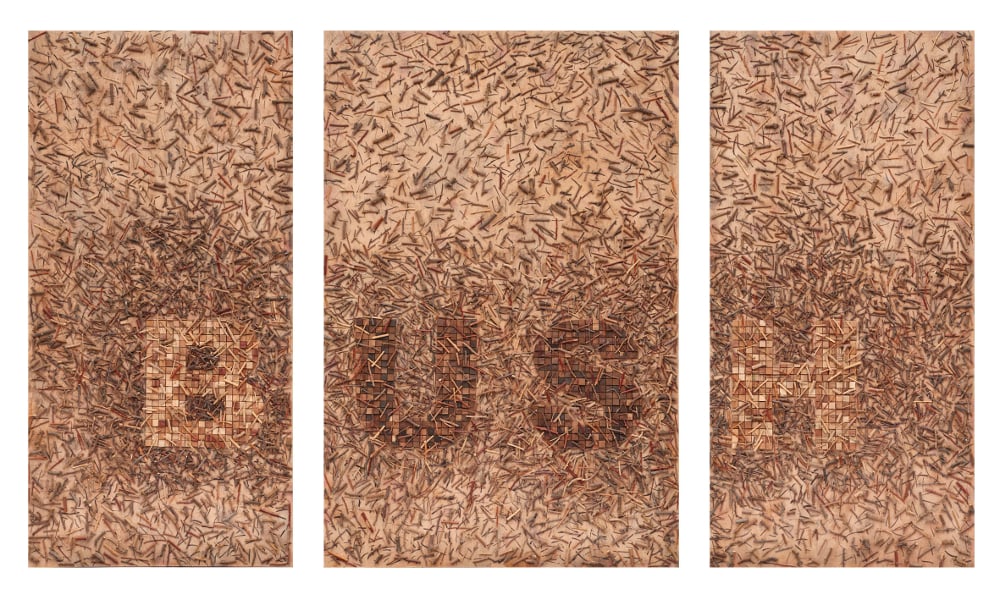Chopping block: Death of African Art is a collection of wooden curios cut into small pieces and mounted on a plywood base.
South Africa’s Socrates is alive and living in an old red-brick double-storey house built on a huge rock adjoining a koppie in Kensington, in eastern Johannesburg. Because you can’t plant trees in the front garden, the wise old polymath has planted about 300 trees – some as old as 40 years – in pots snugly arranged in three rows on the rooftop of his roomy wood and metal workshops. There’s also a large cluster of smaller pots with gorgeous succulents.
“There’s a Namaqua fig, here’s a Cape fig.” He tells you their individual stories as though these are high-achieving children. The names roll off his tongue: melkbos, Transvaal red balloon, crassula, sandpaper fig, black monkey thorn … Like Socrates, artist Willem Boshoff, at 63, is living proof that the “unexamined life is not worth living”. Fortunately, unlike the Greek philosopher to whom that phrase is attributed in Plato’s Apology, Boshoff has never had to face death for his beliefs, even though his pacifism did elicit the hostility of the military during the dark apartheid years.
Life’s riches
Boshoff, whose compelling new solo exhibition Oh My Word! has recently opened at Johannesburg’s Goodman Gallery, is awe-inspiring in the width, depth and breadth of his interests that extend way beyond his art: botany, music, language, politics, philosophy, science, astronomy. Life’s riches for him are not only examined but also shared. He’s taking us on a tour of his house, a cornucopia of plants, art, objects, tools, books, music and photographs. For Boshoff it’s never only a hobbyist’s passing interests, but deep intellectual and lifelong pursuits. He has recently made his huge archives of art, music and botany freely available to the University of the Free State, where he is a special professor in art.
He spends three weeks every few months there. “I take students to do land art near Richmond in the Karoo – there’s a great art gallery, good accommodation. We look at wind farms, solar farms, we look at fracking – then they make art with the soil and the things that are lying around.” We’re sitting in Boshoff’s study at his big Apple Mac where he’s explaining his music filing system using the experimental American composer Morton Feldman as an example. He has all of Feldman’s album names, every musician as well as their instruments, and even reviews, the click of a mouse away.

“The thing with music – and all these things – is that you can have music, but what is that? You can have photographs of plants or you can have plants … You can have a garden, but that doesn’t help much,” he says and taps with his fingertips on his skull above his brain. “The real garden must be here, you must have it here. Music’s the same, you must have it here. If you don’t know how to listen to some of these things, and you don’t find time, just concentrate, and just listen, then you may well be lying when you say you’ve got it.”
You can’t rush music
He plays us a traditional Baka Pygmy song. “Many people when they hear the strange music you have say ‘switch off that shit’. You shouldn’t resist, just switch it off. Music can’t be listened to in a hurry – one track at a time.” But he drastically ups the tempo when it comes to ideas for his art. “I work on about 20 things at a time. Twenty new things and I then have to think ‘which way now’.” His grey-blue eyes are alive. “Many make it to the next exhibition, the others will have to wait for one day maybe … But say I’m 70 and not in the mood anymore … So now that I’m still keen I have to continue.”
You’re 63 now? “Mmm … is it a good or bad thing?” he says and laughs. Boshoff nearly died of lead poisoning a few years ago. “I take painkillers every day for my feet – it kicks in and I fall asleep around 5pm, 6pm. Then at about 10pm I start working again, until two or three or four. I don’t have a problem with getting up early – one gets things done then. If you have a little bit of energy, start with something that you can finish later on … If a farmer doesn’t give his sheep water at night, the sheep will die, but if an artist doesn’t do enough work he’ll go to sleep earlier or drink more wine than usual – no sheep will die.”
An artist “in ceaseless intellectual and creative motion”
Over his more than 30-year career, Boshoff’s work has been shown extensively in South Africa and internationally in many museum exhibitions, art fairs and biennales. Art historian Sue Williamson has described him as an artist “in ceaseless intellectual and creative motion”. Still, his parents, working-class people from Vanderbijlpark, were never completely convinced that art was a proper career for their only son. In 2008, he was awarded an honorary doctorate by the University of Johannesburg. Boshoff’s father had already died by then, but his mother, almost 80, was there for the ceremony.
“I think I was wearing my quite tight old wedding suit. And the shoes – I had them resoled. Then I started worrying, ‘oh fuck, what if I had holes in my soles and every one could see it’. I couldn’t hear a word that guy was saying. I just thought my mom was going to kill me. And afterwards I checked and my soles were fine. My mom was proud – she thought maybe it wasn’t such a bad thing that I had done.” Boshoff says he is happy that, although there’s not such a big audience for his work in South Africa, it is getting bigger. His solo exhibition, which challenges the viewer in a number of ways, is attracting a large audience.
His fans will see two works, Word Woes and Elephant Peep Site, which are physically just metres apart, but emotionally the former is a quirky visual/text gag, while the latter goes straight for your tear ducts. How far is the distance between laughter and crying, though? “I don’t think there’s a big difference because both are cathartic. It is to get that which is ugly and bad out of you. You do that in many ways. In the most basic ways it is to laugh, to sweat, to go to the toilet, to make love.”

Are you a ‘bangbroek’?
One of Boshoff’s earliest works was the anti-conscription Bangboek, a pun on the Afrikaans word bangbroek (scaredy pants). Are you still a bangbroek, I ask him. “If the question is whether I’m still against military authority, the answer is yes. If the question is whether I’m scared of authority, yes.” Whenever he goes to Bloemfontein where there are many people in uniform, he is compelled to perform his upside-down anti-salute.
“And there’s this tank in front of our university that killed people and I want them to take it away. I talk to everyone about it. Some people think I’m crazy, some think I have a point. Now that I’m getting older, it seems I’m talking with more authority”. He smiles. “People are beginning to believe what I’m saying, so maybe now’s the time for me to do something.” Maybe put posters around the tank, paint it another colour or tell some hapless bureaucrat in a stern letter to remove the damn thing.
“I’m not good with that though …” Dadaist Boshoff gets the naughty glint in his eyes: “I’m more the kind of guy who wants to go and crap on the tank – then you’re famous forever. And it counts even more against the thing and then they take it away.”
Talking about fear, are you scared of death? “It’s easy to say you don’t have that fear. I think about it a lot. I have worked my arse off but there are a few things I still want to do …I’m not going to heaven. If they send me to heaven I’ll be pissed off to get people like George Bush and Tony Blair there. And if I go to hell I’ll be right about God – that he’s a bully who sends everybody to hell.
“I don’t really worry about that – if you’re dead, you’re dead.”
No beating about the bush with Boshoff

The press release speaks of “text, subtext, pretext” as “prime areas of concern”, but artist Willem Boshoff traces the title piece of his powerful new solo exhibition Oh My Word! back to when he was a 12-year-old in Vanderbijlpark.
It’s at the preview of the exhibition at the Goodman Gallery in Johannesburg two weeks ago and Boshoff has a mischievous glint in his eyes, his voice laced with laughter: “My teacher at that time was Mr Ackerman, and I had come to the school two years before and he had never taught me and he didn’t like me. The girl who sat next to me – with the blue eyes – she was the head girl. One day we were asked to read a certain passage. It was Afrikaans-speaking kids, so this long English passage was difficult for them. They had to find difficult words and test each other’s spelling. I wanted to win this thing; I was very competitive. I read the passage and thought everybody is going to ask difficult words – I’ll ask a simple word.
“So I had to ask the girl next to me. The head girl. The girl with the blue eyes. The girl I had a crush on.” Boshoff laughs. “So she asked me a really difficult word and I spelt it flawlessly. “And I said, can you spell ‘oh?’?” Boshoff giggles. “Now, she’s Afrikaans-speaking and the word ‘oh’ sounds like the letter ‘o’. And she made sure that she could spell all the difficult words, but the word ‘oh’ is so ridiculous – it’s like asking someone to spell the word ‘no’. That you can hear has two letters, but ‘oh’ has got one. She didn’t quite know what to do but I could see that I had her … I’m going to win this one. The teacher could also see this, and he said, ‘choose another word’. And I said, no. I’m not going to choose another word, it is in the passage, it has got two letters. You could see he felt very sorry for her.
“And he kicked me out of the class.” Boshoff pauses. “And from that day on I thought differently about authority and words … I don’t know. And I said ‘oh’ is my word. Oh my word.” To the left of Oh! is the work Ambush. “Over the last couple of years I have been sitting on my garden refuse dump just to get away from all the hard work – I started cutting the bush, which is now the rubbish dump, into bits and pieces, bucket after bucket. I think they should bring a case against George W Bush for violation of human rights [for the Iraq invasion] – he lied to everyone and should be brought before the international court. So I’m making works to try to facilitate a court case. Added to this, my name is Boshoff – bos means bush and hof is a court.”

The origin of Earth Signal is a question that has bothered Boshoff over the years: “What would the Earth say if she could speak back?” Boshoff thought that she might dearly like to say “fuck off” for the way we have treated her, but schools would censor that. He settled for “piss off”. One of his master’s degree students at the University of the Free State offered her remote farm as the site for this mammoth land intervention. It is in the arid Karoo, close to the imminent and controversial fracking project initiated by the South African government. The 240m2 work – spelling out “Piss Off” in Arial bold typeface – took a week to make out of 160 large bales of wood and 50 bales of straw. Set alight with 110 litres of fire gel and a drum of fuel, it was filmed in September from a helicopter drone hovering 50m in the sky. The result is the Earth now having her say in a nine-minute-long video.
The work Landlocked consists of old industrial metal seals and locks. “You can use seals for many purposes,” Boshoff says. “Some people say they use it to seal meat so that you know nobody has tampered with it, that it stays kosher. It is also used for cartridges, bullets, to seal them off. There are 2?100 of them – they’re like military tanks, they’re locking in that whole work. And behind the work is broken porcelain, very old porcelain, spelling ‘human shields’. When I was working with this, 2?100 people in Gaza were … killed and many were children. I know there were other people also killed but Gaza people could go nowhere. “I thought I can’t accept that, so I made this work as a kind of way of shaking my head in disbelief …” His voice trails off and he exhales a deep mournful sigh.
Oh My Word! is on show until November 8